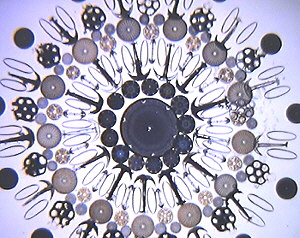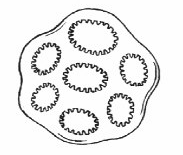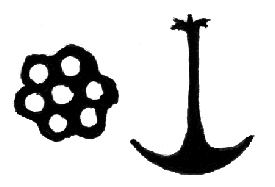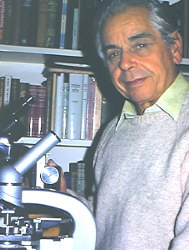It's fun
finding out
by William
Ells
Coniferae, Walnut Tree Lane, Loose, Maidstone, Kent, ME15 9RG,
UK.
In 1947 I learned what a
piddock is, it was in a book called It's Fun Finding Out
by Bernard Wicksteed helped in the more scientific investigations
by Chapman Pincher. The only mention of a microscope is of an
American who spent a lifetime studying snowflakes, he caught them
on black velvet, rushed indoors and put them under a microscope,
he classified more than 5,000 different patterns. This little
book made quite an impression on me whetting my curiousity to
find out about anything of which I had little knowledge.
Forty years on in 1987 I made
photomicrographs of a number of slides of arranged diatoms loaned
to me for the purpose by Bill Boorn of Folkestone, Kent. One of
these slides, described as diatoms from Japan, had some forms on
it that obviously were not diatoms; some looked like little
anchors and some little plates with holes. Now as most regular
readers of Micscape will know I spend most of my time studying
freshwater algae particularly the desmids. But this was something of a challenge, it
would be fun finding out what they were. If not fun, finding
out is very satisfying. Where to start? The double headed
'anchors' reminded me of pictures I had seen of sponge spicules.
| I eventually found the
answer in The Microscope & it's Revelations
by W. Carpenter — revised by W. Dallinger 1891, 7th
Edition page 819. They are plates that are attached with
an anchor in the skin of Holothuroidae the double-ended
anchors may be as I first thought sponge spicules. Fig. 1
right is of the diatom + arrangement. The photo' was
taken using a X20 flat field objective with a X6 eyepiece
at 1/30th sec. on Kodak film using 40 cyan and 40 magenta
filters. |
 |
| The photo's
were put away and forgotten until recently when in the
Micscape paper version I saw a drawing by Wim van Egmond
(shown right) that looks like a Holothurian plate so I
looked out the photomicrographs to compare with Wim's
drawing. I am still not sure about Wim's plate as he
gives no indication of the size of the object. |
 |
 |
As you can
see by the photo' the Holothurian plates are about the
same size as some of the diatoms and smaller than the
central one which gives some idea of the size. Fig. 2
left is a sketch of a plate and an anchor drawn from the
photo'. Well it's fun finding out, but am I right? |
| The
author William Ells, in his friend Don Bruce's study. |
 |
Editor's
notes: if you don't know what a 'piddock' is, as Bill
says, have fun finding out!
Comments and
feedback to Bill Ells are welcomed.
©
Microscopy UK or their contributors.
First
published in August 1998 Micscape Magazine.
Please
report any Web problems or offer general comments to the Micscape Editor,
via the contact on current Micscape Index.
Micscape is
the on-line monthly magazine of the Microscopy UK web
site at Microscopy-UK
WIDTH=1
© Onview.net Ltd, Microscopy-UK, and all contributors 1995 onwards. All rights
reserved. Main site is at www.microscopy-uk.org.uk with full mirror at www.microscopy-uk.net.



